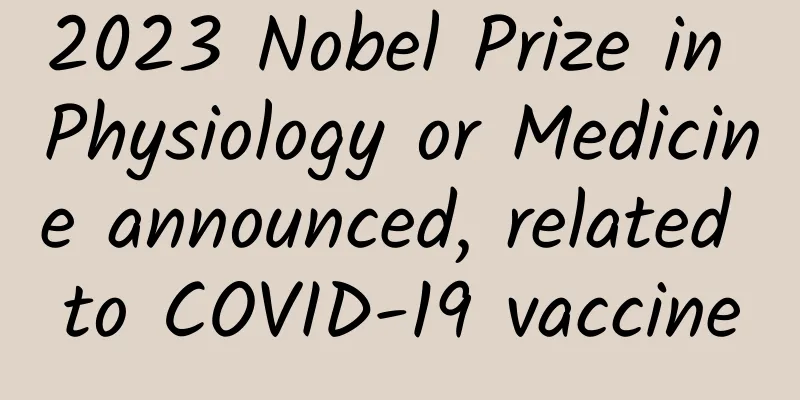2023 Nobel Prize in Physiology or Medicine announced, related to COVID-19 vaccine

|
On October 2, at 11:45 CET (17:45 BJT), the Nobel Prize Committee announced that the 2023 Nobel Prize in Physiology or Medicine was awarded to Katalin Karikó and Drew Weissman for their discoveries in nucleoside base modifications, which led to the development of effective mRNA vaccines to combat COVID-19. Drew Weissman and Katalin Karikó collaborated at the University of Pennsylvania more than 20 years ago to study mRNA as a potential treatment. In 2005, they published landmark research that revealed how to alter mRNA so that it can be used therapeutically and developed an effective strategy that allows mRNA to be delivered into the body to reach the correct target. Pieter Cullis is known for developing ionizable cationic lipids, which are essential for the function of mRNA vaccines. Before their discovery, mRNA vaccines developed to prevent infectious diseases did not effectively and safely stimulate protective immune system responses in animal models. The 2005 study and subsequent discoveries led to successful animal and human trials, and both Pfizer/BioNTech and Moderna licensed the University of Pennsylvania technology for use in their vaccines. The Pfizer-BioNTech vaccine is being deployed in 126 countries around the world, 71 of which are using the Moderna vaccine (unfortunately not including mainland China). According to the Nobel Prize official website, the prize money for each Nobel Prize in 2023 will increase by 1 million Swedish kronor to 11 million Swedish kronor (about 7.3 million RMB). The outside world speculates that the reason is that the Swedish kronor has depreciated significantly against other major currencies since the beginning of this year. This is not the first time that the Nobel Prize has increased the prize money. The following is an introduction to mRNA (message RNA) technology published in "Fanpu" last year. Lessons from the virus For humans, viruses have always played the role of enemies on many levels, but learning from enemies is something humans are very good at, and the same is true for viruses as an enemy. When a virus invades the human body, it can hijack human cells to work for it, producing the genetic material and outer coat it needs, and then producing more viruses. This trick is very insidious, but also very effective. As a cell invader, they can use human cells to quickly accumulate their own strength and then attack the immune system. After figuring this out, scientists began to wonder, if viruses can turn our cells into their protein processing factories, why can't humans use the same strategy to make proteins? It turns out that we can too. After this visionary idea was proposed, scientists have been researching for decades and finally successfully turned it into reality when the COVID-19 pandemic hit. The Pfizer/BioNtech vaccine and other new COVID-19 vaccines mimic this feature of the virus: they use mRNA to instruct our cells to produce protein fragments that can be recognized by the immune system, so that the immune system learns to recognize invaders and develop immunity. The rapid development of this technology is due to the COVID-19 pandemic: the rapid spread of the epidemic has triggered an urgent need for vaccines, prompting the repeated acceleration of new vaccine research and development. People have witnessed the potential advantages of mRNA vaccine development, which is fast and low-cost. Pieter Cullis, a professor of biology at the University of British Columbia in Canada, described it this way: "The rapid development of the COVID-19 vaccine has revealed to us how fast humans can develop new drugs. It took only three months from the birth of the mRNA vaccine to its use." [1] The COVID-19 vaccine is just the beginning. If we can recruit our bodies in this way—like conscription—to proactively fight back against diseases, then everything from bacterial infections to autoimmune diseases, and even difficult-to-conquer genetic diseases and cancers, will not escape the counterattack of this weapon. Cullis described it as "a revolution in the form of medicine, which is developing and testing very quickly." Although we are just at the starting point, and breakthroughs like mRNA vaccines have just appeared, it is no exaggeration to say that mRNA technology will definitely change the situation of human beings fighting against diseases. Since modern times, medicine has been making progress, but there are very few advances that can be called "breakthroughs", and mRNA vaccines can be considered one of them. Why are scientists so excited about the potential shown by mRNA technology and related therapies? This needs to start with the history of vaccines. From live viruses to instruction manuals Early vaccines generally consisted of "live" viruses that often carried mutations that made them less toxic, making them less dangerous than wild viruses, but still able to elicit an immune response in the human body. Live vaccines are very effective and have at one time saved humanity from large-scale disasters, such as the early smallpox and rabies vaccines we are familiar with. But live vaccines also have disadvantages: first, they are very difficult to manufacture because viruses can only be produced by living cells; second, the attenuated version of the complete virus is still threatening and may harm those with weaker immunity; most importantly, the viruses used to make live vaccines have the potential to mutate, which makes them doubly dangerous. For example, after oral administration of the live attenuated polio vaccine, the virus may undergo a reverse mutation in the recipient's body and restore its neurotoxicity, which can cause the virus to spread after being excreted, with serious consequences. Therefore, with the advancement of science, many modern vaccines have abandoned the "live viruses" used in the early days and began to use inactivated viruses to produce vaccines. Now, many subunit vaccines do not even need to use complete viruses (whether dead or alive), but only need to use viral fragments that can be recognized by the immune system, such as proteins or polysaccharides, to play an immune role. However, it is still very difficult to produce such vaccines because any protein-based drugs are limited to one point: they must be produced in living cells. Traditional vaccine development is constrained by this point. From preparing doses for initial testing to large-scale production in the later stages, production capacity issues need to be resolved at each stage. If the candidate vaccine is not effective, it is difficult to adjust its production route. However, just a few decades ago, biologists learned from the reproduction mode of viruses and realized a potential shortcut: instead of injecting viruses or parts of viral proteins into the body, it is better to provide our bodies with genetic formulas for making viral proteins and let the body make these antigens itself. Our bodies are natural protein processing factories, but they usually only produce proteins needed by the human body according to specific templates. These protein formulas are generally permanently stored in our cell nuclear DNA. When cells need to make proteins, they make RNA copies in the form of mRNA. These mRNAs pass instructions to the cell's protein manufacturing factory, the ribosome, and this process will continue for a few hours or days until the mRNA breaks down and protein production stops. Development of mRNA technology In 1990, biologists used mice to demonstrate that adding protein-coding DNA or mRNA to living cells could allow mice to produce large quantities of the protein. This discovery was exciting because it is much easier to produce DNA and RNA in the laboratory than to produce proteins [2]. This experiment proved the feasibility of the "shortcut": if we can accurately analyze the mRNA sequence corresponding to the protein that triggers an immune response, we can produce a prototype vaccine very quickly. Moreover, the production of this vaccine does not require any biological process, so the production speed will be greatly improved compared to traditional vaccines. But there is always a gap between theory and practice. Now that we have figured out the principle, how can we put this "shortcut" into practice? The first obstacle scientists encountered was the human body's defense against exogenous RNA. Since many viruses and parasites use RNA to hijack cells to produce the nutrients they need to reproduce, the human body cannot be completely defenseless - there is a substance called "RNA enzyme" in our blood, sweat and tears, which can quickly break down any RNA found outside the cell. Even if exogenous RNA breaks through this line of defense and successfully invades the cell, it will still trigger a series of defensive responses from the cell. Anna Blakney, a bioengineering expert at the University of British Columbia, described it this way: "In the process of continuous evolution, the human body has learned to use various means to detect and defend against RNA viruses." [1] Some people may ask, don't vaccines need to trigger an immune response in the human body? Indeed, vaccines need to sound the alarm for the immune system to take action against the virus. But if the human body responds so strongly to the introduced RNA that they are destroyed before they can express the required proteins, then there is no way we can get the immune response against the virus. Therefore, most biologists have been negative about mRNA vaccine technology before, and more researchers have focused on the development of DNA-based vaccines. But so far, all trials of DNA vaccines have been disappointing, and no vaccine has been able to trigger a strong immune response. The rapid development of mRNA technology in the later period was due to two key breakthroughs. The first one came in 2005, when Katalin Karikó and Drew Weissman of the University of Pennsylvania successfully chemically modified mRNA so that it could evade immune detection in cells. Since the number of mRNAs destroyed by the cell's defense mechanism was greatly reduced, protein production increased by nearly 1,000 times[3]. The second is a breakthrough in packaging technology. Researchers successfully packaged mRNA in lipid nanoparticles to protect them from being broken down by RNases in the blood and delivered them into cells [4]. This approach had to overcome a huge challenge: RNA is negatively charged, so it will only bind to positively charged lipids, but positively charged lipids are toxic and tend to tear cells apart. Scientists cleverly solved this problem: they developed an initially positively charged lipid that can successfully encapsulate RNA, and once this lipid enters the body, it loses its positive charge and thus its toxicity. After years of gradual improvement, it was not until the 2010s that a drug called patisiran used this key technology and proved in human trials that the technology was safe for the human body, paving the way for the rapid development and use of mRNA vaccines [5]. After these two key breakthroughs, the prospects for mRNA technology began to become clear and promising. In March 2013, the H7N9 avian influenza broke out in China, infecting about 100 people. After the virus's genetic sequence was posted online, a team at Novartis Pharmaceuticals developed an mRNA vaccine candidate from scratch in just eight days. Within weeks, the candidate vaccine was shown to produce good results in mice[6]. Compared with the year or more required for traditional vaccines, the speed of mRNA vaccine development set an astonishing historical record. However, because the H7N9 epidemic ended quickly, the work was not continued. Since then, due to the great uncertainty about the prospects and profits of the new technology, large pharmaceutical companies have given up on following up, leaving the opportunity to smaller companies such as BioNTech and Moderna. Many mRNA therapies were already in trials before the global coronavirus pandemic in 2020. These small trials mainly treat cancer by inducing the immune system to target mutant proteins in tumors, but no therapy has been approved for use in humans. After the global outbreak of the new coronavirus, mRNA technology came at the right time, and the urgent market demand greatly promoted its development speed. It did not disappoint people's expectations-in August 2020, the vaccine BNT162b2 jointly developed by Pfizer and BioNTech became the first mRNA vaccine to receive full FDA approval. After the feasibility of mRNA technology was fully demonstrated during the epidemic, it has won the favor of many investors. Cullis said: "It's like a gold rush...mRNA technology obviously has broad application prospects. You can express any protein you want." Low price is king In recent years, with the development of technology, the pharmaceutical landscape has changed. Some protein-based macromolecular drugs have been approved for marketing. They are more targeted and have better therapeutic effects than traditional small molecule drugs. Among these macromolecular drugs, most are antibodies that are precisely designed to fight specific diseases. Antibodies are a special type of protein macromolecules, which are a type of protective protein produced by the human immune system against disease-causing invaders (such as antigens). Antibodies designed and processed by scientists can be used for a variety of purposes: in addition to the often-mentioned treatment of cancer, they can also help treat autoimmune diseases, a series of infectious diseases, and even difficult migraines. These carefully designed drugs generally have good efficacy, but they also have obvious disadvantages: they are difficult and time-consuming to produce, and therefore incredibly expensive. For some patients who need long-term regular injections of antibodies, this will be an unaffordable amount of money. For example, a fatal kidney disease aHUS (Atypical hemolytic uremic syndrome) can be treated with an antibody drug called eculizumab, but it is one of the most expensive drugs in the world, costing patients about £300,000 (about RMB 2.43 million) per year[7]. Why is it so expensive? If we understand how difficult it is to make proteins in a factory, we may understand. We know that the function of proteins depends not only on the precise arrangement of amino acids, but also on the three-dimensional structure they fold into, and each step of this folding can only occur in living cells. This means that not only does the manufacturing process need to accurately produce this three-dimensional structure, but it also needs to be protected from damage during the subsequent purification, storage, and transportation processes, and all these steps must be customized for each different protein. In contrast, it is much simpler to manufacture mRNA because the most important information they encode - the base sequence - can be manufactured using chemical processes without the need for living cells, and different mRNAs can be manufactured using the same production process. If we can use mRNA technology to transfer the drug manufacturing steps to our bodies, that is, let our bodies actively produce the required proteins according to the instructions of mRNA (just like mRNA vaccines do), the cost of producing the same therapeutic effect will be greatly reduced. Compared to protein drugs, this is a huge advantage, and new therapies will appear faster and more easily. Ideally, we can use mRNA drugs to treat any disease. However, in practice, there is a difference between mRNA drugs and mRNA vaccines: the former allows the body to directly produce large amounts of antibodies, while the latter induces the body to produce antibodies by injecting viral mRNA. Vaccines require only a very small amount of viral protein to work, and because foreign proteins can cause inflammation, the production of viral proteins must be limited to a small part of the body, such as the upper arm muscles, which are generally used for vaccine injections. If the human body is to produce a large amount of antibodies, a large amount of mRNA needs to be injected into the blood. Almost all of them are absorbed by liver cells, which produce specific proteins (antibodies) and release them into the blood. In essence, this process turns the liver into a bioreactor for the production of various protein drugs[8]. This idea was not verified until 2017. Norbert Pardi, a professor of microbiology at the University of Pennsylvania, proved in mice that this idea is possible[9]. This also means that this type of mRNA therapy is still in its early stages. Among the many companies actively developing mRNA therapies, Moderna is quite advanced. In 2019, the company reported for the first time the positive experimental results of mRNA that can directly encode antibodies in the human body. This therapy directly encodes antibodies against the chikungunya virus[10]. It is foreseeable that mRNA technology can be used not only to produce antibodies, but also to produce a variety of other proteins. In August 2021, Moderna began experimenting with a new type of mRNA that can encode two signaling proteins at the same time, one for the treatment of autoimmune diseases and the other for the treatment of genetic diseases by replacing defective enzymes. If such trials are successful, treatments based on mRNA technology may explode. This will be a great boon to patients-not only will the price of the drug become cheaper (compared to protein drugs), but the dose required will also be less than the dose of direct protein injection. In addition, a single dose of mRNA can continue to produce protein for several days, and we can also artificially modify mRNA to make it work longer. There is a slight delay in producing antibodies using mRNA compared to directly injecting them. Some scientists have expressed concerns about the potential lags in mRNA therapies, but studies have found that these small delays may not matter, even in situations that require emergency treatment, such as poisoning. For example, a recent study in mice found that mRNA injections were just as effective as direct injections of antibodies when faced with a lethal dose of botulinum toxin[11]. The future is promising As problems are solved one by one, mRNA therapy is becoming a reality step by step. The most urgent problem to be solved is the targeting problem - if we can find a way to deliver drugs to specific organs or tissues, such as the brain or bone marrow, then the use of mRNA technology will be wider. Although the current level of drug delivery is already sufficient, such as Moderna's AZD8601, which is already in human trials and can stimulate blood vessel growth in wounds that don't heal or in tissues damaged by heart attacks, many genetic diseases are caused by the lack of functional proteins in certain tissues, and it is difficult to deliver mRNA to other parts of the body other than the liver unless it is injected directly into that tissue. In response to this, scientists have proposed several solutions. One strategy is to place mRNA into an empty shell of a virus known to target a specific cell type, using the virus as a vector to deliver mRNA to specific tissues. However, the immune system has memory and will attack viruses that have appeared before, so this method cannot be used again after it has been used once. In August 2021, a team reported that they had successfully created a shell based on a human protein that can serve as a carrier, which is expected to solve this problem [12]. However, Blakney believes that "this is a feasible strategy, but there is still a lot that needs to be improved and tested. Using mRNA technology to fight cancer is achieved through a treatment called "cancer vaccine". The overall idea of cancer vaccines is to allow a person's immune system to accurately distinguish between tumor cells and normal cells, and to stimulate the patient's own immune system to eliminate tumor cells by introducing tumor antigens into the patient's body in various forms (such as nucleic acids, protein peptides, etc.). Since tumor cell mutations vary from cancer patient to cancer patient, cancer vaccines are generally customized and require genetic sequencing of individual tumor cells to identify targets, which are usually mutant proteins that appear in tumor cells. A major advantage of using mRNA technology to customize cancer vaccines is that once these targets are identified, cancer vaccines can be produced quickly and relatively cheaply, and the price of the vaccine may also fall. However, the difficulty of cancer vaccines lies not in technology, but in figuring out the characteristics of tumor cells. Smita Nair of Duke University in North Carolina believes that: finding tumor-specific targets is very challenging, and it is not easy to get the body to actively attack tumor cells, because tumor cells are very cunning, and the proteins on their surface are very similar to those of normal cells, making them difficult to be detected by the immune system. The development of vaccines for cancer is much more difficult than infectious diseases. This work is worth looking forward to, but it is very challenging. According to statistics, there are currently six mRNA therapies for cancer in Phase II clinical trials worldwide, four of which are personalized vaccines. In 2021, a total of 71 mRNA vaccine trials were approved, compared to only two in 2018. Although the vast majority of experiments are still for infectious diseases, people still have high expectations for mRNA therapies. There is no doubt that mRNA vaccines and related therapies have great prospects, but we still need to remain cautious. The chikungunya virus antibody experiment is still the only experiment to date to produce therapeutic proteins in humans, and its complete results have not yet been published, so we cannot be sure that this approach is both safe and effective. We still need to pay close attention to its possible toxicity and conduct toxicity testing related experiments in the later stage. Other relevant animal trials, especially non-human primate trials, have shown positive results and demonstrated the amazing potential of mRNA therapy. Although the road ahead is full of challenges, if we can overcome the remaining difficulties, such as the targeting and storage issues mentioned above (existing mRNA vaccines must be kept frozen), we can use this strategy learned from viruses to treat almost all diseases. In a sense, there is not much that is revolutionary about mRNA vaccines and therapies, because it is proteins that are ultimately responsible, but traditional therapies deliver these proteins directly into the body, while mRNA vaccines use the body’s natural protein-making factory to deliver instructions to achieve the same results. But in terms of the cost and speed of research and development, production, and testing, mRNA technology is completely revolutionary and absolutely superior. In this COVID-19 pandemic, mRNA vaccines have saved hundreds of thousands of lives less than a year after their first introduction. So it is no exaggeration to call mRNA vaccines and the various therapies that will follow them a medical revolution. Its future, and the future of humanity, remains full of hope. References [1] Le Page M. The future of medicine unlocked. New Sci. 2021; 251(3356):38–42. 10.1016/S0262-4079(21)01851-0 PMID:34690400 [2] Schlake T, Thess A, Fotin-Mleczek M, Kallen KJ. Developing mRNA-vaccine technologies. RNA Biol. 2012 Nov;9(11):1319-30. doi: 10.4161/rna.22269. Epub 2012 Oct 12. PMID: 23064118; PMCID: PMC3597572. [3] Karikó K, Buckstein M, Ni H, Weissman D. Suppression of RNA recognition by Toll-like receptors: the impact of nucleoside modification and the evolutionary origin of RNA. Immunity. 2005 Aug;23(2):165-75. doi: 10.1016/j.immuni.2005.06.008. PMID: 16111635. [4] Tenchov R, Bird R, Curtze AE, Zhou Q. Lipid Nanoparticles-From Liposomes to mRNA Vaccine Delivery, a Landscape of Research Diversity and Advancement. ACS Nano. 2021 Jun 28. doi: 10.1021/acsnano.1c04996. Epub ahead of print. PMID: 34181394. [5] Yang J. Patisiran for the treatment of hereditary transthyretin-mediated amyloidosis. Expert Rev Clin Pharmacol. 2019 Feb;12(2):95-99. doi: 10.1080/17512433.2019.1567326. Epub 2019 Jan 18. PMID: 30644768. [6] Hekele A, Bertholet S, Archer J, Gibson DG, Palladino G, Brito LA, Otten GR, Brazzoli M, Buccato S, Bonci A, Casini D, Maione D, Qi ZQ, Gill JE, Caiazza NC, Urano J, Hubby B, Gao GF, Shu Y, De Gregorio E, Mandl CW, Mason PW, Settembre EC, Ulmer JB, Craig Venter J, Dormitzer PR, Rappuoli R, Geall AJ. Rapidly produced SAM(®) vaccine against H7N9 influenza is immunogenic in mice. Emerg Microbes Infect. 2013 Aug;2(8):e52. doi: 10.1038/emi.2013.54. Epub 2013 Aug 14. PMID: 26038486; PMCID: PMC3821287. [7] Dhillon S. Eculizumab: A Review in Generalized Myasthenia Gravis. Drugs. 2018 Mar;78(3):367-376. doi: 10.1007/s40265-018-0875-9. Erratum in: Drugs. 2018 Mar 9;: PMID: 29435915; PMCID: PMC5845078. [8] Van Hoecke L, Roose K. How mRNA therapeutics are entering the monoclonal antibody field. J Transl Med. 2019 Feb 22;17(1):54. doi: 10.1186/s12967-019-1804-8. PMID: 30795778; PMCID: PMC6387507. [9] Pardi, N., Secreto, A., Shan, X. et al. Administration of nucleoside-modified mRNA encoding broadly neutral [10] August A, Attarwala HZ, Himansu S, Kalidindi S, Lu S, Pajon R, Han S, Lecerf JM, Tomassini JE, Hard M, Ptaszek LM, Crowe JE, Zaks T. A phase 1 trial of lipid-encapsulated mRNA encoding a monoclonal antibody with neutralizing activity against Chikungunya virus. Nat Med. 2021 Dec;27(12):2224-2233. doi: 10.1038/s41591-021-01573-6. Epub 2021 Dec 9. Erratum in: Nat Med. 2022 May;28(5):1095-1096. PMID: 34887572; PMCID: PMC8674127. [11] Schlake T, Thran M, Fiedler K, Heidenreich R, Petsch B, Fotin-Mleczek M. mRNA: A Novel Avenue to Antibody Therapy? Mol Ther. 2019 Apr 10;27(4):773-784. doi: 10.1016/j.ymthe.2019.03.002. Epub 2019 Mar 6. PMID: 30885573; PMCID: PMC6453519. [12]https://www.newscientist.com/article/2287676-delivering-mrna-inside-a-human-protein-could-help-treat-many-diseases/ Planning and production Source: Fanpu Original title: "The 2023 Nobel Prize in Biomedicine was awarded to mRNA technology, which not only fights viruses, but also opens the door to hope for a medical revolution" Compiled by Wangwang Editor: Yinuo |
<<: There are also auroras on Mercury, but they haven’t emitted light yet!
>>: We already have a sun, so why do we need to research "artificial sun"?
Recommend
How do plants without mouths "eat" nutrients?
Do plants also have mouths? Of course, if plants ...
Dingxiangyuan's ingenious mechanism for free coffee cup growth campaign
DXY is China's leading medical connector and ...
Should brands cultivate KOLs?
According to media reports, in 2020, more than 30...
BMW X2 will debut in 2017, price may start from 240,000 yuan
The BMW X2 concept car was officially unveiled at...
WeChat's new gameplay is so magical! Be the first to experience WeChat Android beta version
[[401766]] Recently, the new versions of WeChat a...
On the development of "Android" in the next ten years
Electronic products, especially the mobile phone ...
To B products: How to build a complete product operation system?
For most operators , product operations are orien...
Based on React and Vue, how does the mobile open source project Weex define the future?
[51CTO.com original article] This year, many peop...
Xiaohongshu Promotion Guide
Here is a summary of the hot articles in February...
Electric Technology Car News: The former leader of independent brands has become a sports-oriented student. Will the Pentium X80 be recognized when it steps into the examination room again?
When it comes to FAW Group's own brands, in a...
What is the future direction of SEO? In which directions can SEO develop?
I have become more and more lazy recently. I am t...
Anyone with a driver’s license can drive a 99A tank, so how is driving a helicopter any different?
When a helicopter flies low overhead, many people...
APP promotion: How to acquire users through cold start?
Acquiring users is the beginning of achieving use...
10 underwear cleaning liquids vs. ordinary laundry detergents: blood stain killer, antibacterial, gentle on hands, which one is better?
"80% of recurrent gynecological diseases, su...
How can APP improve user stickiness? The most valuable details of Facebook in terms of user experience!
In the Internet era, product competition is fierc...









